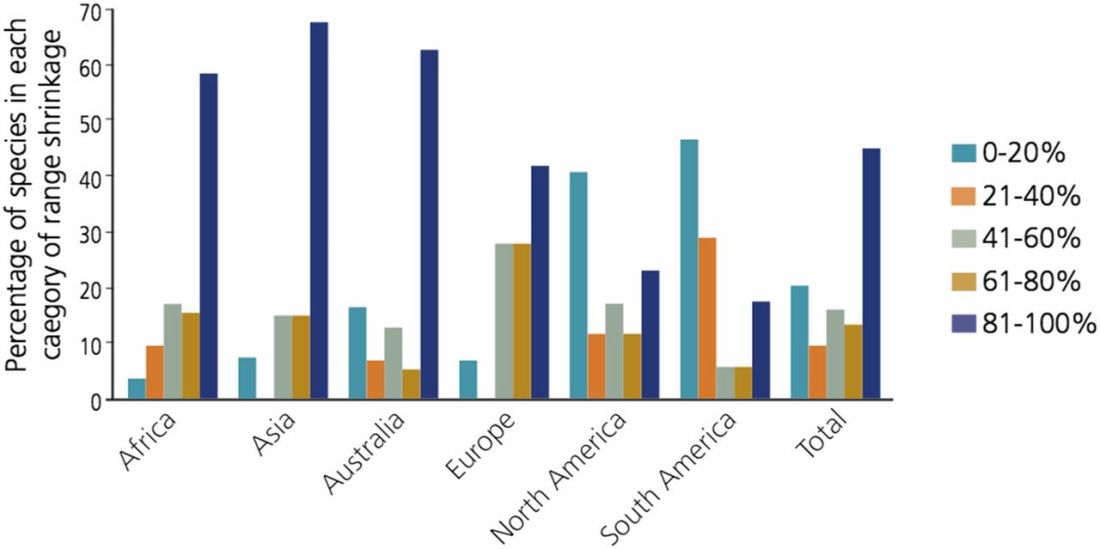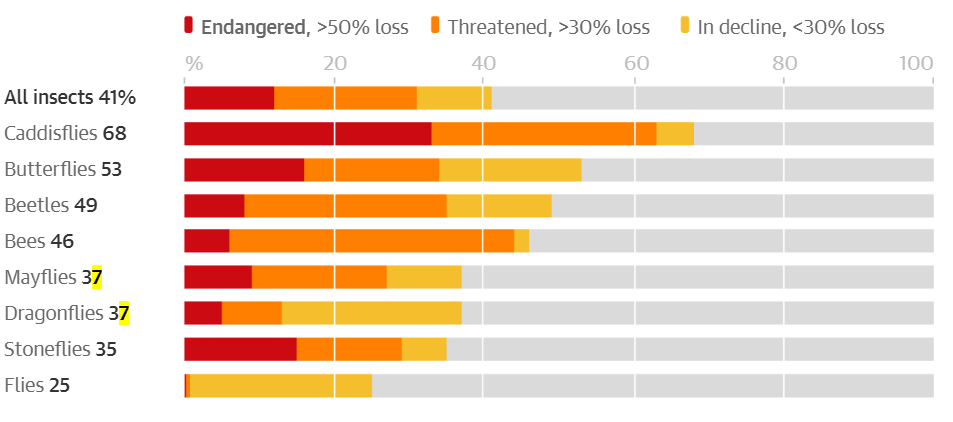Skip ahead slightly to The Facts section if you want to get straight to the hard numbers.
The world is undergoing massive ecological devastation, and scientists have warned that we are, through man-made means, causing a sixth mass-extinction event. Rather than going on a passionate tirade, this article will simply go through, in summary form, the figures and studies so you can make an informed decision yourself. Read the facts, and dig into the sources if you need more information or confirmation.
There are many things we can all do to make a difference in this, but the two most important ones are:
- Spread awareness, by sharing either this article or any of the linked articles and papers, and;
- Contact your state and federal representatives through email, twitter or mail to let them know that these issues need to be addressed through immediate advances in environmental policies and regulations, particularly regarding pesticide use and pollution. If we all speak up, they will have to listen. Provided here and at the end of the article are links for contacting the government representatives of USA (here or here), Australia (here) and the UK (here).
- Reddit user elinordash also has some excellent suggestions here, outlining how to maintain an eco-friendly garden and some non-profits that can be donated to
And now, here are the facts, separated into Animal and Insect categories. There is a lot to take in, so get comfortable.
The Facts
Animals
Biological annihilation via the ongoing sixth mass extinction signaled by vertebrate population losses and declines
We describe this as a “biological annihilation” to highlight the current magnitude of Earth’s ongoing sixth major extinction event
World-renowned scientists do not use terms like “biological annihilation” lightly. In this study, a number of figures showcasing the ongoing collapse of the world’s ecosystems have been found:
- Of 27,000 species of vertebrates (animals) studied – half of all species in the world – more than one third have experienced massive population declines; 30% or more for birds, mammals and reptiles, and 15% or more for amphibians
- Of 177 mammal species analysed in more detail, more than 40% have lost greater than 80% of their populations in the last 100 years
- Of those same 177 mammal species, every single one has lost 30% or more of their geographic ranges
- In the last 100 years, around 200 vertebrate (animal) species have gone extinct – a rate of 2 per year – which is up to 100 times faster than the normal rate of extinction in the absence of humans (that is to say, 200 extinctions would normally take 10,000 years)
- It is estimated that 42% of land-based invertebrate species (insects and the like) are currently at threat of extinction
- The key drivers of this loss of biodiversity are pollution, climate change, habitat loss, invasive species, and environment toxification resulting from industry

The above image shows what proportion of species (y-axis) falls into each range of population decline (colours) in the last 100 years. This shows that the worst loss is occurring in Australia, Asia and Africa, where 60% or more of species have lost between 81 and 100 percent of their populations. The effect is less severe – but still very pronounced – in places like North America, with 25% of species having lost more than 80% of their populations.
An estimate from the World Wildlife Foundation in cooperation with 59 scientists across the world suggests that humanity has wiped out 60% of all mammals, birds, fish and reptiles in the last 50 years.
In a study as far back as 2004, a full 14 years ago, it was found that of 232 fish populations studied, more than half had experienced declines of greater than 80% in population size. Some shark species in certain regions of the ocean have seen declines of 75%, and the Atlantic Cod, a species of fish that has been feeding humans for at least 500 years, has seen up to a 99.9% decline in certain overfished areas since the 1960’s.
In Australia, the great barrier reef – one of the seven natural wonders of the world – is near to the end of its life. Thanks to a combination of ocean acidification and average temperature increases, the reef lost half of its coral between 2016 and 2018, with other coral reefs around the world experiencing similar losses. As some of the most biodiverse places on Earth, the loss of reefs around the world could cause significant problems to the already failing and endangered species of the world.
Insects
Plummeting insect numbers ‘threaten collapse of nature’
Unless we change our ways of producing food, insects as a whole will go down the path of extinction in a few decades
Though the scientific paper is unfortunately not free to view, this article by The Guardian does an excellent job of summarising the contents and provides links to a variety of other studies. The study has shown that insect populations are being devastated by the overuse of pesticides, global increases in temperature caused by climate change, and destruction of habitats. So much so, in fact, that it is estimated insects will be entirely extinct in as little as 100 years, with the effects of this loss of biomass being felt far, far sooner (even now).
It should go without saying that the loss of all insect life will mean the loss of all life, as insects form an integral part of of the world’s ecosystems that cannot be replaced. Even before they are all gone, the loss of insects in the coming years will mean massive reductions in food production and wildlife across the globe.
- More than 40% of insect species are declining, and 30% are in danger of extinction
- The total mass of insects has been falling at a rate of 2.5% per year for the last 25 years, and the trend is continuing
- This means a loss of one quarter of insect biomass every 10 years
- The rate of insect extinction is 8 times higher than that of birds and mammals, which are also declining alarmingly fast
The 2.5% rate of annual loss over the last 25-30 years is “shocking”

Another recent linked study has shown that Puerto Rico has lost an astounding 98% of its ground insect population and 80% of its canopy insect population in the last 35 years, almost entirely due to an increase of 2 degrees celcius in average forest temperatures, signalling an imminent collapse of its ecosystems.
German scientists have reported a 75% reduction in flying insects across their protected nature reserves in the last 27 years, with Europe as a whole reporting a 50% reduction in grassland butterfly populations in just 21 years, as well as bees and moths experiencing similar trends.
It’s all connected and when the invertebrates are declining the entire food web is going to suffer and degrade. It is a system-wide effect.
Yet another study shows a decline of 58% of butterflies across farmed land in the UK in just the 9 years between 2000 and 2009, with the problem worsening since then.
What this means
It cannot be disputed that we need animals and insects in order to survive. They form the basis of the Earth’s ecosystem and are a part of every single food generating process we have. If they go, we go. The fact that insect and animal populations are experiencing catastrophic decline means that we, as human beings, are collectively in a crisis – a crisis that needs to be addressed immediately and without restraint. If not, the problem will escalate within our lifetimes. It is no longer an issue for our children or their children, but a problem for us, now.
What you can do
- Spread awareness by sharing either this article or any of the linked articles and scientific papers, getting involved in any environmental groups in your area, or discussing the issue with coworkers and family;
- Contact your state and federal representatives via email, twitter or mail and urge them to take action in curbing the loss of animal and insect populations, particularly through policies and regulations that reduce use of pesticides and inhibit pollution.For those in the USA, you can reach your representatives here or here, Australians here, and UK here.You can write a personalised message, or a shorter one with a link to this article if you’d prefer. If you’re from elsewhere, take the time to contact your government as well – it will take fast, combined global effort to start reversing the effects of climate change and extinction before it reaches a point of no return, if we’re not already there.
- Reddit user elinordash also has some excellent suggestions here, outlining how to maintain an eco-friendly garden and some non-profits that can be donated to
I cant believe this is not headline news on every major paper. This is far more important than dow up or down some fraction of 1%.
LikeLiked by 1 person
thanks for a beautiful world..The powers that be have their agenda, We cannot change what has been set motion. Thanks a lot Monsanto. Planet destroyer.
LikeLike